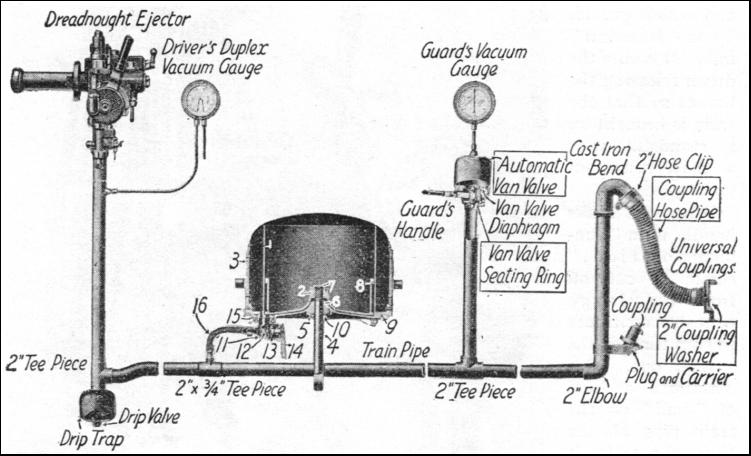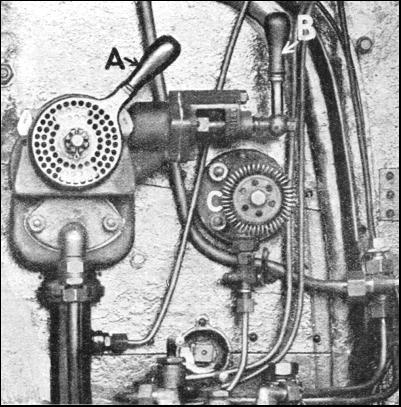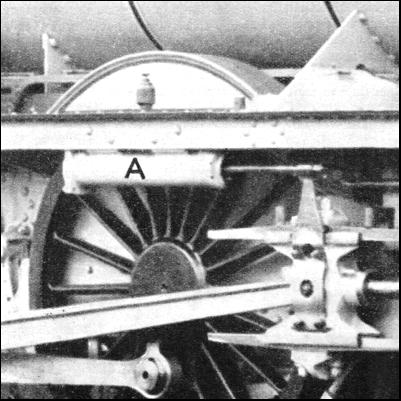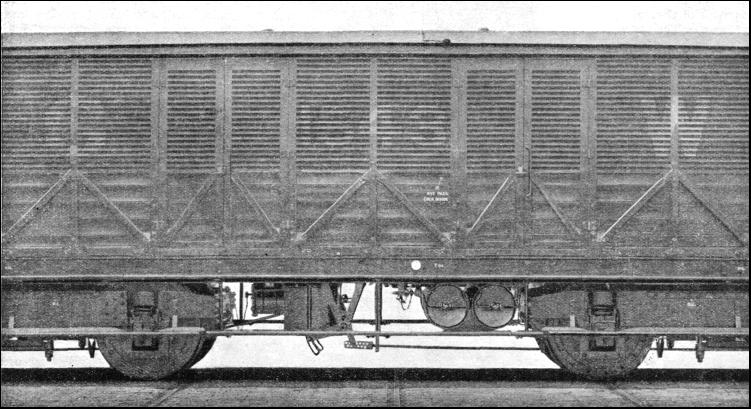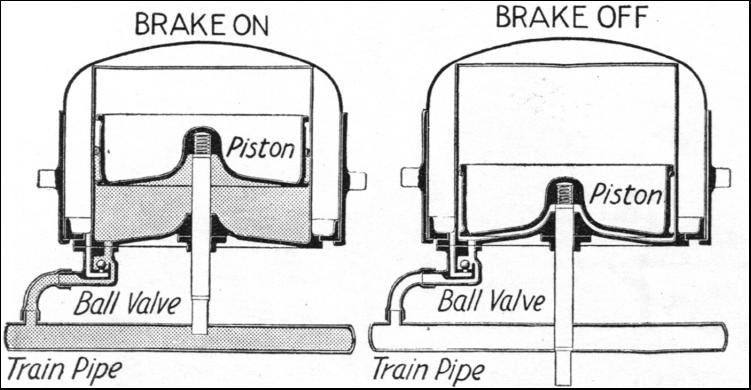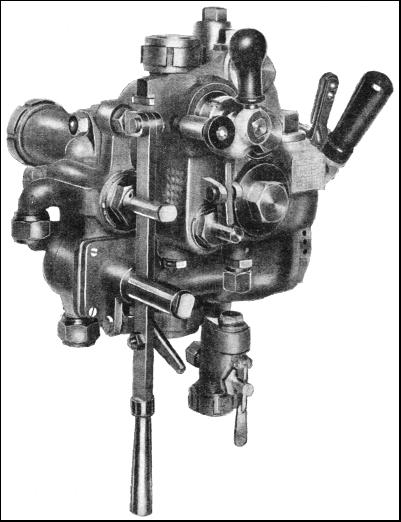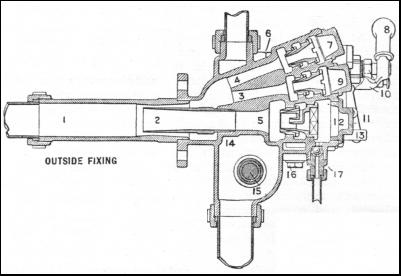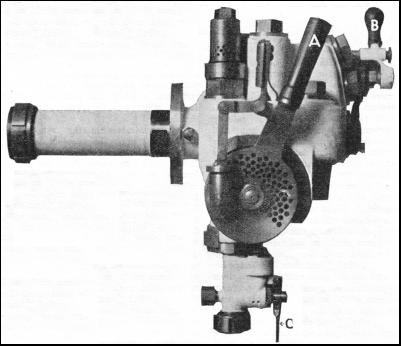|
|
THERE is a saying that "competition is healthy." This in railway mechanics is decidedly so, as it makes for efficiency. One of the most outstanding examples is that of the rival braking systems, compressed air and vacuum. Both are efficient and reliable ; each possesses advantages ; and before the general grouping of the railways, each had its adherents. The London, Brighton and South Coast, Great Eastern, North Eastern, London Chatham and Dover, and other lines used the Westinghouse air brakes, while the London and North Western, London and South Western, Great Northern, Midland, and others, pinned their faith to the vacuum automatic brake. Perhaps the best example of the rival brakes working side-by-side, as one might say, was that of the Underground in the old steam days, when the District locomotives and trains were provided with the Westinghouse apparatus and the Metropolitan had vacuum brakes. Both companies' engines were identical, and often—as when running on the Inner Circle—worked exactly the same services over the same sets of metals. Even to the present day, the "rivals" go hand-in-hand ; on the Southern Railway, the electric trains use the quick-acting Westinghouse brake, and the steam trains are all vacuum-fitted. Each system gives perfectly satisfactory service. The vacuum brake was invented while the compressed-air brake was in its infancy. It was hardly likely that any one system would be allowed to reign unchallenged ; and inventors who are always busy on the brake problem, hit on the idea of letting air at atmospheric pressure operate the pistons of their brake cylinders, by creating a vacuum in one end of the cylinder. Nature abhors a vacuum, and does her best to fill it with anything convenient. This can be demonstrated by a small glass syringe with a piston which is air-tight. Put a finger over the nozzle, and pull out the piston-rod as far as it will go ; this creates a vacuum in the syringe. Take away the finger, and air rushes in with a distinct hiss and "plop." Repeat the experiment, but this time hold the nozzle under water before removing the finger, and water will rush into the syringe as soon as the nozzle is uncovered. Again repeat the first experiment ; this time do not uncover the nozzle, but let go the piston-rod. It will fly back, because of the pressure of the atmosphere on the outside of the piston, and absence of pressure—hence no resistance—inside the syringe. Pull out the piston-rod once more ; attach a short length of rubber tube to the nozzle, and suck the air from the syringe. As one draws out the air and reduces the amount in the barrel of the syringe, the piston will move inwards, as the pressure of the atmosphere acts on the outer side of the piston ; and there one has the vacuum brake in the embryo. The ejector is oneself, the rubber tube is the train pipe ; the syringe is the brake cylinder ; and if one attached the pull-rod of a miniature brake set to the piston-rod it would apply the brakes. As with the compressed-air brake, the first vacuum brake was of the non-automatic. or "straight" type. Under the engine, and under each coach, was a brake cylinder which was not unlike a concertina, being collapsible. One end of the "concertina" was fixed, and the other end was attached to the brake pull-rods. All the "concertinas" were connected by a pipe running right through the train, connexions between the carriages being made by flexible hoses with universal snap couplings, after the same style as the air brake.
The locomotive was fitted with an "ejector," consisting of a casing containing a cone with a steam nozzle at the back of it, steam being supplied from a valve on the boiler backhead. The rear end of the cone was connected to the train pipe via the driver's valve, which acted the same as a three-way cock, one position connecting the train pipe with the ejector, and the other position cutting off this and opening the train pipe to the atmosphere. When the driver wanted to apply the brakes, he opened the steam valve, and placed the brake valve handle in the first position. Steam blew through the cone and took the air from the train pipe with it. This mixture went to the smoke-box and chimney through a large pipe attached to the front end of the cone. To release the brakes, steam was shut off, and the handle placed in second position, admitting air to the train pipe and destroying the vacuum. When the air was drawn from the train pipe by the ejector, the pressure of the atmosphere would close up the "concertinas" and so exert a pull on the brake rods. With air in the train pipe, pressure was equal inside and outside the "concertinas," and the brakes would either release themselves or else be pulled off by release springs, as in the case of the air brake. The vacuum brake, in this primitive form, underwent several improvements ; the steam and brake valves were combined, so that the brakes could be applied or released by movement of one handle only. Various details were made better ; but the brake as a whole suffered from drawbacks similar to those of the "straight" air brake. If anything happened to the ejector or apparatus on the engine, or if leakage occurred in the train pipe and connexions, the brake could only be applied with reduced power, or not at all. It was sluggish in operation ; also—most important of all—if a train broke in two, or a hose was torn apart by accident, the brakes on the entire train were put out of action. Again, as in the case of the air brake, one small gadget added to the brake cylinders reversed the action of the brakes, and made them automatic. This was nothing more formidable than a simple ball valve, located at the point where the connexion from the train pipe was attached to the brake cylinder. The brakes were now "off" all the time a vacuum was maintained in the train pipe ; and as soon as air was admitted, either by the driver, guard, or by accident, the brakes were automatically applied, the action being as follows : When the engine was coupled on to the train and the driver opened the ejector steam valve, the air was extracted from the train pipe, but this did not apply the brakes, as air was taken from both sides of the pistons in the brake cylinders, leaving them in equilibrium, or "balanced." And as long as the pressure or vacuum on both sides of the pistons remained equal, the brakes stayed in the "off" position. Air was drawn by the ejector from the undersides of the pistons direct ; but to get from the upper side of the pistons, the air had to lift the ball valve and pass through it.
To apply brakes, the driver pulled back the handle of the brake valve, which first cut off steam from the ejector, and then admitted air to the train pipe. This rushed along to the undersides of the pistons, but was unable to get into the space above them, as it forced the ball valves down on their seats and held them there, effectually barring its own passage. Pressure on the undersides of the pistons now being greater than the pressure above them, they were forced upwards ; and the rods being coupled to the brake gear through the usual pull-rods, the brakes were applied. The same thing happened if the train broke in two, or a hose became damaged in any way, so that air was admitted to the train pipe. This is the action of the automatic vacuum brake, as used to-day, except that, to speed up its action on long trains, air can be admitted at various points in the train pipe by means of rapid-acting valves or "accelerators," and also through the guard's emergency valve. If a train is left standing in a station or siding with the brakes on, and there is no engine attached, the brakes can be released, if necessary, by what railwaymen call "pulling the strings." The "strings," or wires, are attached to a small valve on each brake cylinder, which admits air from the lower to the upper side of the piston, destroying the vacuum, and thus equalizing the pressure on both sides of the piston. It will be seen from the above description that to operate the vacuum brake on a train of modern weight and length, an efficient ejector is needed to extract the air with the utmost rapidity from the train pipe when releasing the brakes, and to maintain the vacuum while running, as there is always a certain amount of leakage at hose connexions and other places. About the best known is the "Dreadnought" type. This ejector is fixed either on the right or left hand side of the cab, according to which side the driver stands. It consists of a gun-metal casting, with steam and air cones in it, and union fittings for connecting up to the steam, exhaust and train pipes. On one side of the casting is a large perforated disk, fitted with a handle. The underside of this has ports which register with other ports formed in the seating. There are three positions of the handle, "brake off," "running position," and "brake on."
The "brake off " position is used to release the brakes quickly, after they have been applied to stop at a station, or for a signal stop. And in this position, steam at full pressure passes through the large cone in the ejector body, rapidly extracting the air from the train pipe, and blowing it away through the exhaust pipe and up the engine's chimney. This explains the origin of the peculiar whistling roar which many locomotives make just as they are on the point of stopping, and which puzzles "non-technical" folk. It is only the driver releasing the brakes so that the train is brought to a standstill with a minimum of jerking. When the brake handle is in "running position," steam is cut off from the large cone, but continues to pass through the smaller one. This maintains a kind of "pull" on the train pipe all the time the train is running; by extracting any air that gets in through leaky hose couplings and so on, keeps the brakes released. The noise made by the steam passing the small cone and blowing up the exhaust pipe has frequently been ascribed by "non-engineers" to the "kettle singing," under the impression that the boiler of the locomotive was emulating its little sister on the kitchen stove. With the handle at "brake on," steam is cut off from the large cone, the action of the small cone is isolated by a covering port in the air disk, and air is admitted to the train pipe. It will thus be seen that, by judicious use of his brake valve, a driver can graduate his brake applications to a nicety, any desired pressure being obtainable at the brake blocks from "full-on" to "right off" ; and the pressure can be increased or decreased as required. Although the principle of the ejector has remained the same from the beginning, there are various forms of ejectors in use, and they have been greatly improved in detail, principally in the reduction of the amount of steam needed for the extraction of a given quantity of air. One of the latest is the "super-Dreadnought," which has two small ejector cones, and is especially adapted for use on long trains with a number of leaky connexions. The two small cones working in unison will maintain the vacuum on a comparatively small steam consumption. One cone working alone is sufficient for a reasonably "tight" train.
Some railways, notably the Great Western and the L.N.W. section of the L.M.S., use a pump to maintain the vacuum while the train is in motion. They can thus dispense with the continuous blowing of the small ejector cone ; the ejectors on the engines have the large cone only. Engines fitted with vacuum pumps give audible notice of it by the loud "ticking" sound they make when running, caused by the action of the pump valves. On outside cylinder engines the pump is usually attached to the guide-bar, either above or below the piston-rod, and the pump-ram is driven by an arm attached to the cross-head. As these pumps are fairly powerful, and would create in the train pipe a vacuum higher than that created by the ejector, a relief valve is usually fitted so that the vacuum in the train pipe shall not exceed a certain figure. This is like a safety valve working "upside down," the pressure of the atmosphere opening the valve and allowing the air to enter when the pump is doing its duty in too conscientious a manner. If a high vacuum is created in the train pipe, naturally it will be the same in the brake cylinders also ; and unless the ejector can create a vacuum equal to that in the brake cylinders above the pistons, the brakes will not release after application and it means "pulling the strings" right through the train and starting all over again. The full working range is between 18 and 25 in. of vacuum, the brakes usually being worked between 21 and 23 in. Vacuum gauges are provided in the engine cab and the guard's van, and are calibrated in inches instead of pounds for very much the same reason that one says there are "two degrees of frost" when the thermometer stands at 30 degrees Fahrenheit, or two degrees below freezing point. If one had a glass tube bent U shape, and put some mercury into it, the mercury would rise to the same height in both legs of the tube ; and there would be equal air pressure (about 15 lb. to the sq. in. at sea-level) on the surface of the mercury in each leg. If one started to suck the air from one of the tubes, for each of those 15 lb. of pressure that one drew out, the column of mercury would rise 2 in. in the tube. Thus 20 in. of vacuum on the gauge corresponds to 10 lb. per sq. in. air pressure.
As there is only this comparatively low pressure available to work the brakes, the brake cylinders have to be much larger than those used in compressed-air brake systems. A section of the usual type of cylinder is shown below. The whole is made of thin cast or pressed metal, the working cylinder being covered by a dome-like casing which serves as a vacuum chamber. Its purpose is to increase the space above the piston The piston is hollow and very deep, and contains a long packing groove in which is a big rubber ring, of circular section ; a glorified edition of those used to seal preserved fruit jar caps. As the piston moves, this ring rolls between piston and cylinder, and forms a perfectly airtight yet practically frictionless packing. The piston-rod passes through an airtight gland in the cylinder cover. Some brake cylinders, instead of having the vacuum chamber self-contained, are provided with a separate chamber. The chamber is merely a large cylindrical tank, similar to an air-brake auxiliary reservoir, except that it is lighter. It is directly connected to the upper part of the brake cylinder by a suitable pipe. Other types of brake cylinders are in use. One kind does not use a rolling ring nor a ball valve ; the ring is replaced by a rubber band operating in much the same way as a cup leather on a cycle-tyre inflator. Six holes are made in the piston head, and when the vacuum is created in the train pipe, air is drawn through these holes and passes the rubber band. Another type dispenses with the deep cylindrical piston, and in its place has a flat disk which is clamped to an India-rubber diaphragm secured between the flanges of the two halves of the cylinder, very much after the style of the piston and diaphragm (known as a "leather hat") of a village pump. The diaphragm being flexible, the piston can move up and down the cylinder, yet no air can pass except by way of the valve. This type of cylinder is known to railwaymen as a "sack."
Another kind of "sack" is used in a horizontal position under the carriages, similar to air brake cylinders, and contains two diaphragm pistons. The space between them is always under vacuum ; to apply the brakes, air is admitted at both ends. Sometimes the piston-rod, instead of passing through a gland, is covered by a piece of flexible hose, tightly clamped to both the piston-rod and the boss on the cylinder cover through which it works. When the brake is applied, and the piston rod is drawn into the cylinder, the hose wrinkles up like a closed concertina bellows. Some brake cylinders are fixed, the piston-rod being connected to an arm on a cross shaft under the vehicle, and connexions are made between other arms on the shaft and the brake pull rods. Another form of brake cylinder, called the "crab," has the piston-rod directly connected to the longer arms of two bell cranks on the cylinder itself, the short arms of the bell cranks being attached directly to the brake rods, dispensing with the cross shaft. The cylinder, being mounted on trunnions, can swing and adapt itself to the rods, rendering the gear self-compensating. The guard can apply the vacuum brake from his van, the valve being of the lift type in a casing, and operated by a handle which unseats it to admit air to the train pipe. This valve also has an automatic action which assists the driver to make a quick stop in emergency. The casing above the valve is under vacuum, as it communicates with the train pipe through a small hole in the valve stem ; consequently a rush of air into the train pipe acts against the underside of the valve, as it acts on the piston of the brake cylinder, lifting it against the vacuum in the casing. Air then rushes in and helps to apply the brakes quickly. On some lines where slip coaches are used, a special arrangement is provided whereby the guard can apply and release the brake as well, so that he can stop the slip portion of the train at the required part of the platform. Passengers also can stop a train if necessary. The passenger alarm signal is directly connected to the brake gear, so that anyone wishing to stop the train in emergency begins to apply the brakes. A small pipe connects the train pipe with a valve box on its end of the coach near the top, the valve consisting of an India-rubber seated flap-valve, which is lifted by a rotating shaft passing across the end of the coach. The alarm chain is attached to cranks on the ends of the shaft, which also carries indication disks. If a passenger pulls the chain, the flap-valve is opened and air is admitted to the train pipe, beginning the application of the brakes; at the same time the indication disk turns to a vertical position and shows from which coach the alarm was given. The train is finally brought to a standstill by the driver or guard. Every brake system must necessarily present difficulties, and many ingenious devices have been invented and perfected by railway engineers to ensure reliability of the vacuum brake under all conditions.
An important, though small, component of vacuum brake equipment is the "drip-trap," fitted at the lowest point on an engine brake pipe, so that any water accidentally introduced will be collected and discharged. This fitting comprises a nearly spherical chamber with holes at the top and bottom. The top opening leads into a screwed joint on the engine brake pipe, and the lower hole is provided with an automatic drain valve. This valve consists of a ball which is forced upwards on to a seating by atmospheric pressure against the vacuum in the brake pipe. When the vacuum in the engine and train pipes is destroyed the ball falls from its seating and permits the escape of any water which may have collected in the trap. On the vacuum being restored, the ball is again drawn upwards against the seating, scaling the trap against the pressure of the atmosphere. Hose couplings, which join the brake pipe of one coach to that of the next throughout the train, are always a source of interest to the travelling public. Half the fascination of watching a railwayman "couple-up" two sections of a train lies in the apparently careless "twist" given to the hose connexions of the vacuum brakes. These couplings are quite simple and have remained substantially the same in design as when they were first introduced, over half a century ago. The free end of each hose (the other end is secured to the train pipe) is fitted with a flanged casting. These castings are exactly alike, and are provided with curved projections or "horns" at the lower edges and a lug and slot at the top edge of each. The faces of the flanges are provided with rubber rings, resembling the sealing rings to be found on domestic preserving jars. To couple-up, it is only necessary to hook the curved horns together and allow the two flanges to touch with the respective lugs resting in the slots of the adjacent castings. As the hose couplings drop downwards in a U-shaped curve, their weight, combined with the external air pressure against the vacuum inside, is sufficient to hold the flanges together. The rubber surfaces prevent the incursion of air.
Uncoupling is easily accomplished by lifting the two fittings apart. The last hose-coupling on a train is placed over a "dummy" or flanged stopper, which effectively seals the end of the train pipe. A similar fitting is used on the front of the engine. In some instances couplings are used with extra long lugs, provided with a chain and pin. Where vehicles of differing types, for example, are to be coupled together, the position of the flanged castings would not be at the bottom of the "U" formed by the hoses, but the pin through the lugs holds the flanges in close contact, despite the fact that they are hanging nearly vertically. Another very interesting type of coupling is that used between an engine and tender. This coupling is placed on the auxiliary pipe between the engine and tender, and retains the automatic action of the brake in the event of the locomotive being accidentally separated from the tender when running. Each half coupling is fitted with a ball which, when the coupling is together, is held off its seating by means of a protruding peg on the other half. Should the engine break away from the tender, these balls are forced on to their seatings by the inrush of air, and the pipes thus become sealed. The application of the vacuum brake to a locomotive has been illustrated early on this page, but under modern conditions it has not always been practicable to make use of this system. In certain instances there is not sufficient room on a locomotive for a brake cylinder large enough to be effective, and consequently a brake is employed which is operated by steam at the full pressure of the boiler. It is generally the custom to make use of the vacuum brake for the train and the steam brake for the locomotive. The two systems are used conjointly, and their action is simultaneous. This is effected automatically by means of the control gear of the vacuum brake, which also governs the action of the steam brake on the locomotive. The ejector in the locomotive cab, which controls the vacuum brake on the train, is fitted with a special valve automatically controlling the operation of the locomotive steam brake.
In this apparatus, shown by the illustration above, a piston is held in place by the vacuum in the train pipe, and this in turn maintains a steam valve on its seating against the pressure of steam in the boiler. When the brake is "off," the effect of the vacuum on this piston resists pressure of the steam. But when an application of the brake is made the power of the piston is reduced, and steam rushes through the valve, previously closed by the piston, and enters the steam brake cylinder, so applying the engine brakes to the wheels. When the vacuum is restored in the train pipe the steam is allowed to escape from the brake cylinder, which at the same time is shut off from the main steam supply of the boiler. The partial application of the vacuum brake also ensures a partial application of the steam brake, so that the locomotive shall be retarded in equal proportion to the train. The vacuum automatic brake is also used on electric trains on certain railways, the vacuum being created by an exhauster, driven by an electric motor.
Many thanks for your help
|
   Share this page on Facebook - Share  [email protected] |


